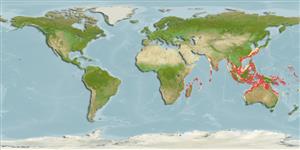Environment: milieu / climate zone / depth range / distribution range
ນິເວດວິທະຍາ
ສັດທະເລ ອາໄສຢູ່ໃກ້ໜ້າດິນໃຕ້ພື້ນທ້ອງນ້ຳ; ລະດັບຄວາມເລິກ 45 - 177 m (Ref. 27821). Deep-water
Indo-West Pacific: southern India and Sri Lanka to the Philippines, south to northern Australia and Papua New Guinea (Ref. 6192).
ຂະໜາດ / ນ້ຳໜັກ / Age
Maturity: Lm ? range ? - ? cm
Max length : 30.0 cm TL ຕົວຜູ້/ບໍ່ມີເພດ; (Ref. 48635)
Differ in color from the more common D. orientalis by the lack of blue lines in the pectoral fins and has a centrally placed dark blotch on the fin instead. Also the body lacks black spots (Ref. 48635).
Found in the continental shelf (Ref. 7300, 75154). Rarely observed due to mud-preferred habitats (Ref. 48635). Benthic (Ref. 75154). Not fished commercially but taken incidentally throughout its range. Usually caught near shore. Marketed fresh occasionally (Ref. 3392).
Life cycle and mating behavior
ການຈະເລີນເຕັມໄວ | ການສືບພັນ | ການວາງໄຂ່ | ໄຂ່ | ຄວາມດົກຂອງໄຂ່ປາ | ຕົວອ່ອນ
Eschmeyer, W.N., 1997. A new species of dactylopteridae (Pisces) from the Philippines and Australia, with a brief synopsis of the family. Bull. Mar. sci. 60(3):727-738. (Ref. 27821)
IUCN Red List Status (Ref. 130435: Version 2024-1)
Threat to humans
Harmless
Human uses
ການປະມົງ: ທີ່ເປັນການຄ້າໜ້ອຍ; ຕູ້ປາ: ເປັນສີນຄ້າ
ເຄື່ອງມື
Special reports
Download XML
ແຫຼ່ງອີນເຕີເນັດ
Estimates based on models
Preferred temperature (Ref.
123201): 20.4 - 27.9, mean 25.2 °C (based on 461 cells).
Phylogenetic diversity index (Ref.
82804): PD
50 = 0.5234 [Uniqueness, from 0.5 = low to 2.0 = high].
Bayesian length-weight: a=0.00676 (0.00333 - 0.01373), b=3.10 (2.91 - 3.29), in cm total length, based on LWR estimates for this species & (Sub)family-body (Ref.
93245).
ຊັ້ນເຂດຮ້ອນ (Ref.
69278): 3.5 ±0.5 se; based on size and trophs of closest relatives
ຄວາມຢືດຢຸ່ນ (Ref.
120179): ສູງ, ປະຊາກອນຕຳ່ສຸດທີ່ໃຊ້ເວລາສອງໜ້ອຍກວ່າ 15 ເດືອນ (Preliminary K or Fecundity.).
Fishing Vulnerability (Ref.
59153): Low vulnerability (20 of 100).
